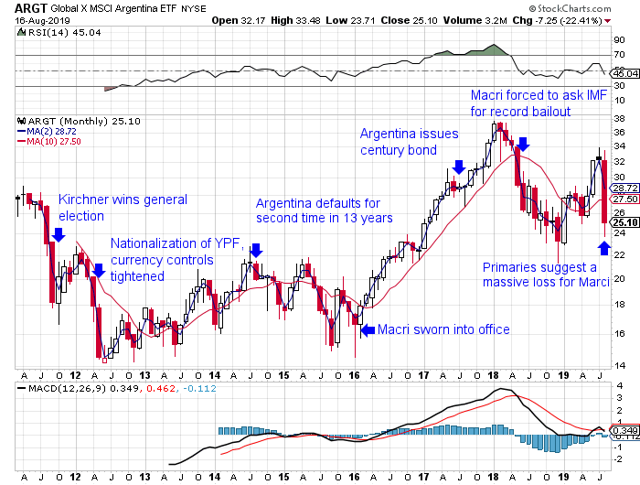[ad_1]

For the amount of ink that was spent on Argentina last week, you would assume the country was the lynchpin holding together the Western hemisphere, not a perennial problem child with a market cycle of booms and busts so regular you could set your watch by it. But once again, just the hint of Cristina Fernandez de Kirchner returning to power was enough to send investors fleeing the country, as equity markets crashed by as much as 50% last Monday, which fed a vicious chain reaction that saw the nation’s credit rating hit by both Fitch and S&P by Friday. Painful for those handful of investors using the largest of the two Argentina ETFs, the Global X MSCI Argentina ETF (ARGT), but with all of $77 million in assets after last week’s rout, we expect that it was a core holding for many investors.
For all of the almost predictable messes, some investors still can’t resist the urge to gamble on the South America’s biggest problem child (and isn’t that saying something), as Daniel Cancel’s recent piece in Bloomberg, “Wiped Out Once Again, Argentina Bulls Sift Through the Ashes,” points out. Maybe it’s because, as you can see in the chart below, Argentina’s market cycles (using a domestic ETF as a proxy) are so well-timed to political events that it takes away from having to do any actual analyzing.

But investors wondering if they should “Buy when there’s blood in the streets” would be better off checking out our ETFG Quant Report, where ARGT saw its Behavioral score fall from the top 25 of the over 1200 funds we’re scoring to almost the bottom 10% of that same pool in just one week! And while some contrarian indicators are showing signs of life, our models have yet to reach a risk/reward level compelling enough to risk it all on the chance that this time it’s going to be different.
The Mouse that Roared
Argentina is a hard country to wrap your mind around; it was one of the largest economies in the world at the start of the 20th century, before a seemingly endless cycle of dictators, hyperinflation, bond defaults and literal textbook economic shenanigans have left the country as a study in how not to run a nation. And yet, Argentina is still a larger economy and a member of the G-20 whose per capita GDP, whether nominal or adjusted for purchasing power parity, is above several of its neighbors, including Brazil as well as one its largest export markets, China. In fact, we think that if you were to chart the members of the G-20 by their market capitalization or even just their weightings in the various U.S. emerging market indices, Argentina would be the biggest outlier.
The country was recently upgraded to emerging market status by MSCI. Its weighting in the index is well below other G-20 problem children like South Africa (5.49%), Brazil (7.85%) or even Mexico (2.41%), now suffering through its own Presidential-inspired loss of investor confidence. Maybe that’s why there are exactly two funds (tracking the same index) which offer pure Argentinian exposure, with ARGT being the largest with roughly $77 million in assets.
And while much ink has been shed about Argentina’s recent century bond, the total weighting given to the country’s debt by the J.P. Morgan EMBI Global Core Index, the most well-known emerging market bond index, is now just 1.74%, down from 2.4% earlier in the week. We can cite any number of more aggressive equity and bond ETFs or mutual funds with larger allocations to Argentina, but the net result is still that for all the media attention, your potential exposure to the latest trouble in the southern cone is negligible at best.
Let’s face it, Argentina’s most profound impact on the investment environment here in the U.S. is as a punch line in gold bug newsletters telling you to beware the coming hyperinflation, which is why we’re calling it the “mouse that roared.” And while there’s no doubt that the latest drama in Argentina has some hit some investors hard, we think the ratio of economic impact to American portfolio’s versus words printed is widely out whack in this case. More than a century of vicious booms and busts have left the country so far out on the economic periphery that it was only just upgraded to “emerging market” status, where its weight in the widely followed MSCI Emerging Markets Index is a mere .4%. Putting that into perspective, there are at least 6 Brazilian stocks that have a greater weighting than all of Argentina.
Which is probably why some U.S. emerging market managers will overweight the country, since it offers a chance to pick up some “alpha” by investing in a G-20 economy that is seriously underrepresented in the most common EM benchmarks. After all, if you bought into the largest of the two pure-Argentinian ETFs, ARGT, at the end of 2015 following Macri’s victory, you would’ve been up close to 100% by the end of 2017! That’s more than double the return of the iShares MSCI Emerging Markets ETF (EEM), which Argentina wasn’t even a part of at the time and now holds just a .4% weighting in after returning to the index in 2018. Maybe that’s why investors have been willing to use single-country ETFs whose three-year trailing historical standard deviation are more in line with a gold mining fund like the VanEck Vectors Gold Miners ETF (GDX) than a broader EM index.
And yet, we’re tempted by the fact that ARGT scores so well in our own quantitative models and whether you really can make a persuasive argument for why Argentina should be on your watch list. The short answer is that we can’t.
Fastrack to the Danger Zone
We’ve discussed our Quant Models in other posts, so we don’t recap our system here, but to describe just how truly awful last week was for ARGT, you have to understand that our scores are based on multiple factors that can be broadly grouped under the headlines of “behavioral” and “fundamental.” We’ll limit ourselves today primarily to the behavioral. Like most analysts, we look at the fundamentals as being more important in helping to predict long-term returns, and despite last week’s sell-off, ARGT is hardly a bargain. As of the close of 8/16, we have ARGT trading at P/E and P/B multiples in the upper third of its historical rankings, a significant drop from the very high levels it was trading at on 8/9, but still not at what anyone would consider a bargain level.
Looking at the technical picture, ARGT finds itself in a situation that might be considered something of a mixed bag. Our behavioral scores are driven by what we call sentiment, primarily contrarian indicators that could act as rocket fuel to provide much needed lift to an ETF. In the case of ARGT, the sentiment scores are largely unchanged, thanks to the fact that short interest and implied volatility remain incredibly high, which is not surprising given that the fund is historically highly volatile, while also having a cyclical price pattern that short-sellers can’t resist. In fact, the level of ARGT shares issued remains relatively flat, and while we don’t have a final fund flows estimate yet, it would appear that ARGT likely didn’t experience any strong outflows of assets last week. Given how bad the performance has been and how low the expectations are going forward, selling the shares short might be one of the primary reasons the fund is still going.
The 25% sell-off last week might have made the fund slightly more attractive on a price multiple basis, but all the rocket fuel from sentiment is useless without a positive trend, which is desperately lacking at this point. Our technical scores look at multiple measures of momentum over different time frames, and as you can imagine, the picture wasn’t pretty. In fact, ARGT had excellent technical scores at the end of 8/9, especially in the short term, as the fund was enjoying a strong 2019 despite the need for an IMF bailout, not to mention incumbent President Macri’s weak showing in early polls. Fast forward to 8/16 and the aggregate technical score has plummeted more than 75% to some of the weakest levels in ARGT’s history, although the intermediate- and longer-term scores still have more room to fall.
Beware the Falling Knife
All investors have an inner contrarian that reminds them the best way to make outsized profits is to take the unexpected or overlooked trade. To buy when there’s blood in the streets, and given the gloomy quant outlook and an even gloomier macro outlook, not to mention almost two months before the presidential election, there doesn’t seem to be much chance outside of a major recession for the situation to get much bloodier! But if you won’t listen to our quant talk, consider the technical outlook.
Technical analysis might seem a strange thing for a data shop to discuss, but given how small the asset base of ARGT is and how unique the strategy, we assume a large part of its ownership base consists of macro traders or other hedge funds who rely on technical. You can see from this weekly chart of ARGT that the fund doubled from Macri’s inauguration in December 2015 roundtrip to a peak in 2018 just before the latest fiscal crisis hit, causing a massive erosion of those gains before the fund found support at a prior level from 2016.

Even with the most recent sell-off, ARGT is still above the lows set in late 2018, which would seem like a natural destination for the fund’s price as investors contemplate the litany of woe between now and the next election. It’s quite possible the fund only stopped at its current price last week, as it also happened to be the 200-week moving average.
Unfortunately for ARGT bulls, there’s still more room to run – downwards – from that 2018 low. In this case, all the way back to the where the Macri rally began in late 2015 – roughly $16 a share, or 36%, below last Friday’s close. That might seem extreme, but given the fund isn’t in oversold territory and only in the early stages of a moving average crossover, now doesn’t seem to be the time for bravery.
We’d point out another bit of investment wisdom, “Beware catching the falling knife.”
Disclosure: I/we have no positions in any stocks mentioned, and no plans to initiate any positions within the next 72 hours. I wrote this article myself, and it expresses my own opinions. I am not receiving compensation for it (other than from Seeking Alpha). I have no business relationship with any company whose stock is mentioned in this article.
Additional disclosure: Assumptions, opinions and estimates constitute our judgment as of the date of this material and are subject to change without notice. ETF Global LLC (“ETFG”) and its affiliates and any third-party providers, as well as their directors, officers, shareholders, employees or agents (collectively ETFG Parties) do not guarantee the accuracy, completeness, adequacy or timeliness of any information, including ratings and rankings and are not responsible for errors and omissions or for the results obtained from the use of such information and ETFG Parties shall have no liability for any errors, omissions, or interruptions therein, regardless of the cause, or for the results obtained from the use of such information. ETFG PARTIES DISCLAIM ANY AND ALL EXPRESS OR IMPLIED WARRANTIES, INCLUDING, BUT NOT LIMITED TO ANY WARRANTIES OF MERCHANTABILITY, SUITABILITY OR FITNESS FOR A PARTICULAR PURPOSE OR USE. In no event shall ETFG Parties be liable to any party for any direct, indirect, incidental, exemplary, compensatory, punitive, special or consequential damages, costs, expenses, legal fees, or losses (including, without limitation, lost income or lost profits and opportunity costs) in connection with any use of the information contained in this document even if advised of the possibility of such damages.
ETFG ratings and rankings are statements of opinion as of the date they are expressed and not statements of fact or recommendations to purchase, hold, or sell any securities or to make any investment decisions. ETFG ratings and rankings should not be relied on when making any investment or other business decision. ETFG’s opinions and analyses do not address the suitability of any security. ETFG does not act as a fiduciary or an investment advisor. While ETFG has obtained information from sources they believe to be reliable, ETFG does not perform an audit or undertake any duty of due diligence or independent verification of any information it receives.
This material is not intended as an offer or solicitation for the purchase or sale of any security or other financial instrument. Securities, financial instruments or strategies mentioned herein may not be suitable for all investors. Any opinions expressed herein are given in good faith, are subject to change without notice, and are only correct as of the stated date of their issue. Prices, values, or income from any securities or investments mentioned in this report may fall against the interests of the investor and the investor may get back less than the amount invested. Where an investment is described as being likely to yield income, please note that the amount of income that the investor will receive from such an investment may fluctuate. Where an investment or security is denominated in a different currency to the investor’s currency of reference, changes in rates of exchange may have an adverse effect on the value, price or income of or from that investment to the investor
[ad_2]
Source link Google News

